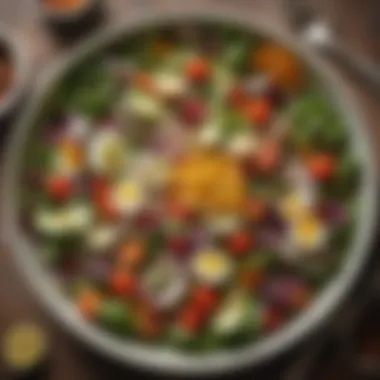Easy and Delicious Dishes for Potluck Gatherings


Intro
Potluck gatherings are a staple of community and camaraderie, where everyone contributes a dish to share, creating a communal feast that celebrates both diversity and simplicity. Navigating the culinary landscape of such events doesn’t always have to involve grandiose dishes or labor-intensive recipes. Instead, effortlessly delightful offerings can shine just as brightly on the table.
This guide will take you through a variety of uncomplicated yet scrumptious potluck dishes. From appetizers that whet the appetite to desserts that can satisfy the sweetest of teeth, there’s something to tickle every palate.
By selecting ingredients that are readily available and easy to work with, home cooks of all levels can craft satisfying dishes. Get ready to explore recipes that are perfect for the occasion, while also offering insights into preparation techniques and serving suggestions. The essence of potluck dining lies in sharing and enjoying good food together, making it easy to foster connections and spark conversations.
Let’s kick things off with a closer look at a range of recipes that highlight the essence of this culinary gathering.
Prelude to Potluck Dining
Potluck gatherings are a unique blend of culinary creativity and community spirit. They bring together family, friends, and even sometimes neighbors, fostering a sense of togetherness through shared food. The beauty of these events lies not just in the variety of dishes presented but in the opportunity for each attendee to contribute something personal. This contribution goes beyond mere flavor; it serves as a reflection of culture, tradition, and individual taste.
Having a shared meal can break barriers and strengthen bonds. With each dish, stories are often shared, laughter mingles with good company, and new memories are forged. Plus, the practicality of potlucks is hard to beat—you get a spread of flavors without the burden of a single person doing all the cooking!
In this section, we dive deeper into the essence of potluck dining, examining what makes it so special and offering essential tips for a successful potluck experience.
The Concept of Potlucks
Potlucks are not merely about food; they encapsulate the idea of sharing and collaboration. Families and friends gather with their signature dishes, creating a smorgasbord that caters to various tastes. Whether it’s a casserole, dessert, or salad, each dish adds to a larger narrative—the story of the people coming together.
The term "potluck" itself suggests spontaneity. It harks back to the olden days when guests brought whatever they had to share, creating an unexpected feast. It emphasizes inclusivity—no one is left out, and everyone feels valued. With each person bringing something different, potlucks allow for culinary exchanges that broaden palates and invite new experiences.
Essentials for a Successful Potluck
For potluck gatherings to be enjoyable for all, there are certain essentials to consider:
- Diverse Menu Choices: Aim for a mix of flavors and dietary options. Think about including meat, vegetarian, and vegan dishes, ensuring everyone finds something they enjoy.
- Communication: It’s crucial to communicate about what everyone is bringing. A simple group chat can prevent duplicates and inspire creativity—one person can bring a spicy pasta salad, while another might choose fragrant baked chicken. With a little planning, you’ll end up with a well-rounded selection.
- Catering to Allergies: Bear in mind that some guests may have dietary restrictions or allergies. Be sure to ask everyone to note any major allergens in their dishes, or perhaps offer a small sign for each dish indicating its ingredients.
- Serving Supplies: Remember to provide or coordinate serving utensils, plates, and cutlery. Bringing extras can save the day in case something gets forgotten!
- Beverages: While dishes are the heart of the meal, beverages deserve their due attention. Consider having a mix of alcoholic and non-alcoholic options—infused waters, homemade sodas, or themed cocktails can really elevate the gathering.
No potluck is complete without a touch of creativity and organization. Earning your stripes in the art of potluck hosting contributes to unforgettable gatherings that will be talked about for years to come.
Savory Appetizers
When it comes to a potluck gathering, the essence of the event often starts with a selection of savory appetizers. These small, tasty bites serve as an excellent icebreaker, encouraging mingling and conversation among guests. More than just fillers, appetizers can set the tone for the meal, reflecting the host's creativity and consideration for their guests' palates. They invite people to try a bit of everything, allowing for a relaxed dining experience.
Appetizers, especially when they are easy to prepare and transport, play a critical role in potluck success. They can appeal to a variety of tastes, dietary preferences, and restrictions, ensuring that everyone feels included. Savory options can complement the main dishes while tantalizing the taste buds from the get-go. In a nutshell, a well-thought-out appetizer section not only enhances the meal but also fosters a warm and welcoming atmosphere among attendees.
Cheese and Charcuterie Board
Selecting Cheeses
Choosing the right cheeses for a cheese and charcuterie board is a fundamental aspect. Different varieties can offer a range of flavors, textures, and aromas. A balanced selection might consist of soft, hard, and blue cheeses, each bringing something unique to the table. Popular choices like Brie, aged Cheddar, and Gorgonzola illustrate this variety perfectly, making them a sure fire hit at any gathering.
The beauty of selecting cheeses lies not only in taste but also in presentation. A well-arranged board can be a conversation starter in itself. However, finding cheeses that complement each other can be a delicate balance; for instance, a rich cheese may overshadow a milder option. It's worthwhile to consider the overall texture and flavor profile to ensure a delightful experience for all.
Meats to Include
Including an assortment of meats elevates the cheese and charcuterie board. Options like prosciutto, salami, or student sausage can offer depth and variety. These meats not only contrast with cheeses but also provide protein that many guests appreciate. The savory and salty elements are particularly appealing.
One must consider dietary restrictions—such as vegetarian or halal options—when selecting meats. It's beneficial to label items on the board, ensuring everyone can find something that suits their taste or dietary needs. A mostly meat-heavy board might not cater to all, hence a thoughtful blend can create a delightful symphony of flavors.
Accompaniments and Presentation
The accompaniments to a cheese and charcuterie board can transform it from simple to spectacular. Fresh fruits like grapes, dried fruits, nuts, or honey can add sweetness and texture that balances the savory elements. Breads and crackers provide a necessary vessel for enjoying these delights.
Presentation matters greatly in this aspect. Arranging everything beautifully can elevate the visual appeal of the board. A colorful display of fruits alongside earthy tones from cured meats can be visually enticing. However, one must be cautious. Overcrowding the board can lead to chaos and confusion. Simple yet elegant arrangements are often the most effective.
Stuffed Mini Peppers
Ingredients Overview
When preparing stuffed mini peppers, the choice of ingredients becomes pivotal to the flavor outcome. Popular fillings include creamy cheeses, grains, beans, or even seasoned ground meat. These ingredients not only add flavor but can also contribute to the visual appeal by making the peppers vibrant and inviting.
Moreover, using fresh vegetables can enhance nutritional value. The appeal lies in the hand-held nature of mini peppers, they serve as a convenient option for guests to nibble on without the need for utensils. This contributes to a relaxed potluck atmosphere while adding an element of fun.
Preparation Steps
Preparation of stuffed mini peppers is relatively simple yet effective. First, one must preheat the oven and get started on your filling based on chosen ingredients. Core the mini peppers and stuff them as generously as possible. Baking them usually takes around 15-20 minutes, allowing the flavors to combine beautifully. There’s a certain satisfaction in watching the colors brighten while they cook.
While this requires some time, the trade-off is more than worth it; the hands-on preparation invites creativity. Moreover, they can be assembled ahead of time, making life easier on the day of the potluck.
Serving Suggestions
These stuffed delights can be served warm or at room temperature, making them suitable for various settings. For added flair, consider garnishing with fresh herbs or a drizzle of balsamic reduction.
Offering a variety of fillings helps cater to different preferences. One might even label the different types to ensure guests know what they’re grabbing. These little pointers can make serving simpler while adding an element of choice.
Bruschetta Variations
Classic Tomato and Basil
This iconic Italian starter resonates with many traditions, making it an excellent addition to potlucks. The freshness of ripe tomatoes paired with fragrant basil creates an unforgettable experience for the palate. A drizzle of olive oil adds a subtle richness that binds the flavors beautifully.
Moreover, this version is lightweight and refreshing, which complements heavier dishes that may come later in the meal. The vibrant colors and simplicity make it appealing to both the eyes and the palate, leading to its popularity.
Mushroom and Goat Cheese
For a more sophisticated take, mushroom and goat cheese bruschetta steps into the spotlight. The earthy flavors of sautéed mushrooms blend exquisitely with the creamy tang of goat cheese. Adding a hint of garlic or herbs can further enhance this dish.
This variation tends to evoke a sense of comfort and warmth, making guests remember it long after the gathering. It's a less common option that can stand out in a sea of more typical fare and adds a bit of elegance to the spread.
Avocado and Feta
An avocado and feta bruschetta presents a modern twist that's particularly appealing in today's culinary landscape. Rounded and creamy, this combo offers a different texture profile that's both nourishing and satisfying.


It's essential to ensure the avocados are ripe but firm for the best results. The feta adds a satisfying saltiness. Plus, it caters to various dietary preferences, often aligning well with those looking for lighter, healthy fare. This dish often ends up being a crowd favorite due to its light, refreshing nature and appealing colors.
This diverse array of appetizers not only satisfies hunger but also ignites conversation, paving the way for an enjoyable and memorable potluck experience.
Hearty Main Dishes
When it comes to potluck gatherings, hearty main dishes play a vital role in satisfying a crowd. These are the meals that often serve as centers of attention, offering both flavor and substance. Think of them as the backbone of any potluck spread, bringing everyone together around a table filled with warmth and comfort.
The beauty of hearty main dishes lies in their flexibility. They cater to a mix of dietary preferences and can easily accommodate large servings, making them a practical choice for communal dining. Often low-maintenance in terms of preparation, these dishes allow the host to spend less time in the kitchen and more time mingling with guests.
One-Pot Pasta Dishes
Recipe Ideas
One-pot pasta dishes, like a creamy Alfredo or a zesty marinara, are a golden ticket for potlucks. They have that comforting allure that everyone craves, and you can whip them up without needing a million pots soaking in the sink. The simplicity of using just one pot reduces cleanup time, which is a win in any gathering! Plus, they're pretty forgiving when it comes to ingredients—just toss in whatever veggies or proteins you've got lying around.
These recipes not only save time but also allow flavors to meld together beautifully. Picture a spicy garlic shrimp pasta that's rich and fragrant, enticing everyone with wafts of deliciousness. One-pot pasta dishes pull together a great deal with minimal fuss, making them a highly popular choice for anyone planning a potluck.
Cooking Techniques
The technique behind one-pot cooking is where the magic happens. Typically, you start by sautéing aromatics, then you add pasta and liquid, allowing it to come to a simmer. This method lets the pasta absorb all those rich flavors directly from the sauce, resulting in a meal that bursts with taste. The integration of each component into a single pot ensures that no element gets lost in translation, making for a cohesive dish.
This approach also means you can easily adapt cooking times based on the pasta type or add items as needed without having to worry too much about precision. Just keep an eye on it! However, timing is crucial here; you want to avoid ending up with overcooked mush.
Flavor Enhancements
Flavor enhancements are the secret sauce that elevates any main dish. A sprinkle of fresh herbs like basil, or a drizzle of olive oil right before serving can make a world of difference. Similarly, a dash of lemon zest at the end can add brightness to a heavier dish.
What’s more, incorporating seasonal vegetables can enhance not only the flavor but also the color, making the dish visually appealing. Each enhancement can turn a simple pasta bowl into a memorable experience. But be careful; there's a fine line between enhancement and overdoing it, so it’s wise to taste as you go.
Slow-Cooked Pull-Apart Sandwiches
Types of Meats
When diving into the world of slow-cooked pull-apart sandwiches, the choice of meat speaks volumes. Options like pulled pork, beef brisket, or even chicken thighs melt in your mouth after being cooked for hours in a slow cooker. The slow cooking process allows the meat to become incredibly tender, making it easy to shred and pile onto bread.
These sandwiches appeal to meat lovers and provide a great texture contrast. Juicy, rich flavors paired with crispy or soft buns can create a well-balanced dish that leaves folks coming back for seconds. One caveat might be that some may prefer lighter options, so including a vegetarian alternative is always a thoughtful touch.
Cooking Method
The hallmark of a great pull-apart sandwich lies in the cooking method—embracing low and slow is the way to go. Cooking in a slow cooker allows the meat's natural juices to be retained, resulting in a fork-tender result packed with flavor.
This method is particularly beneficial for potlucks because you can set it and forget it—much of the cooking is hands-off. This gives you the freedom to focus on other dishes or get ready for the gathering attendees. Just keep a check on the temperature to ensure everything stays safely cooked!
Condiments to Consider
Condiments can turn an already fantastic sandwich into something unforgettable. Options like tangy barbecue sauce or a rich homemade aioli add distinct flavors that complement the meat’s profile. Some folks might enjoy loading their sandwiches with pickles, jalapeños, or slaw to bring in some crunch and acidity, giving contrast to the tender meat.
Having a variety allows guests to personalize their sandwiches, which can make the experience all the more enjoyable. However, it’s wise to have a selection available, catering to both adventurous eaters and those who prefer milder flavors. Extra condiments on the side can also ensure the sandwiches remain neat and tidy.
Vegetarian Casseroles
Layers and Ingredients
Vegetarian casseroles are a fantastic addition to potlucks, offering hearty options for guests who prefer to skip meat. These dishes are usually built in layers, combining various ingredients like veggies, grains, beans, and sauces to create a balanced meal.
The magic of casserole lies in how the flavors meld together during baking, creating a symphony on every plate. Layering not only provides textural contrast but also allows for beautiful presentation when served hot from the oven. However, it is important to keep a mindful eye on ingredient combinations to avoid overwhelming flavors, especially if using potent ingredients.
Baking Instructions
Baking a casserole means combining all those delightful layers and letting them meld into a single dish. The general rule of thumb is to bake until bubbly and golden on top. Following temperature guidelines is crucial, but convenience means it can often be prepared in advance and simply popped into the oven right before guests arrive.
Having a highly adaptable baking method is a gift for potluck hosts who need to keep things simple while ensuring a delicious outcome. If you’re working with a variety of ingredients, just remember to allow for adequate cooking time to ensure everything is heated through properly!
Pairing Tips
Pairing a vegetarian casserole with complementary sides or toppings can enhance the overall experience. Crisp salads, bread rolls, or a light vinaigrette can provide freshness against the richness of a casserole. Additionally, nuts or seeds can elevate the texture and presentation if sprinkled on top just before serving.
Being mindful of flavors and textures can make each potluck setting a showcase for culinary creativity. However, it’s also wise to keep in mind potential dietary restrictions, ensuring that whatever is chosen pairs well with the casserole, balancing out the meal.
Refreshing Side Dishes
When planning a successful potluck gathering, the side dishes play a vital role in creating a well-rounded meal. They bring color, crunch, and variety to the table, helping to elevate even the simplest of main dishes. Refreshing side dishes are particularly important as they balance the often hearty and rich flavors of the main courses. With the right salads and vegetable medleys, you can brighten the palate and keep your guests returning for more.
Seasonal Salads
Components to Consider
Choosing the right components for your salad can significantly impact its success at a potluck. Think fresh greens, grains, and colorful vegetables. Each component contributes its unique flavors and textures, offering a delightful mix. Seasonal ingredients tend to be more flavorful and less expensive than out-of-season ones.
Key Characteristics: Incorporating seasonal produce not only brings a burst of freshness but also provides an opportunity to celebrate local agriculture. When making a salad, consider ingredients like heirloom tomatoes in summer or hearty kale in winter.
By combining different elements like nuts, seeds, and fruits, one can create a salad that's both healthy and exciting.
A well-crafted salad can be the talk of the potluck, enticing everyone to take a second helping.
Dressing Options
The right dressing can transform a good salad into a great one. Whether it’s a simple olive oil and vinegar blend or a more complex tahini dressing, the choice of dressing should complement the salad without overwhelming its components.
Key Characteristics: Vinaigrettes are generally popular, offering a lightness that pairs well with various flavors. On the other hand, creamy dressings add richness, enhancing salads with ingredients like avocado or yogurt.
One unique aspect of dressings is the ability to prepare them in advance. This not only saves time on the day of the potluck but also allows flavors to meld together beautifully.
Serving in Large Bowls


Serving salads in large bowls is not just practical but can also become a centerpiece for the table. Large bowls invite guests to help themselves, encouraging a communal feel to the gathering. Presenting dishes this way also minimizes the need for individual plating, allowing hosts to focus more on socializing.
Key Characteristics: Large containers can hold generous portions, ensuring everyone gets enough to enjoy. Plus, it’s an excellent way to showcase the vibrant colors of your ingredients.
However, one should be mindful that not all salads hold up well when left out for long. Choosing sturdier ingredients can prevent a soggy mess, ensuring the salad remains appealing throughout the event.
Roasted Vegetable Medley
Choosing Vegetables
When it comes to selecting vegetables for a roasted medley, versatility is key. Root vegetables like carrots, potatoes, and beets seem to work wonders because they roast beautifully, developing deep flavors. However, seasonal vegetables like zucchini or bell peppers can also make for a colorful and appealing dish.
Key Characteristic: Fresh, locally sourced vegetables tend to have the best flavors and textures, making them a popular choice for potlucks. Roasted vegetables not only taste great but also provide a visually stunning dish that can be enjoyed by everyone, including those who might be vegetarian.
Roasting Techniques
Roasting vegetables highlights their natural sweetness and creates a lovely caramelization on their surfaces. A few simple steps make for the best results: preheat the oven, toss veggies in olive oil, season adequately, and space them out on a baking sheet. This method ensures even cooking and prevents steaming.
Key Characteristic: Roasting not only enhances the flavor but also develops a crispy outside with a tender interior. The aroma that fills the kitchen as they roast is enticing as well, adding to the overall potluck experience.
Variations in Seasoning
Seasoning can make or break your roasted veggies. A little salt and pepper go a long way, but why stop there? Experiment with fresh herbs, spices, or even citrus zests to take those flavors up a notch. A sprinkle of rosemary or a dash of chili powder can transform the basic roasted veggies into a standout dish.
Key Characteristic: Flexibility in seasoning allows you to customize the dish to cater to your potluck crowd. However, while experimenting is fun, be cautious not to go overboard, as overly complicated flavors can clash with the natural taste of roasted vegetables.
Grain Salads
Choosing Grains
When it comes to grain salads, the choice of grains can greatly impact the texture and nutritional value of the dish. Options such as quinoa, farro, or barley offer protein and an interesting chewiness that distinguishes them from leafy salads.
Key Characteristic: Whole grains are not just filling; they also provide essential nutrients and can absorb flavors from dressings remarkably well, making them a good addition to any potluck spread.
Add-ins and Toppings
Add-ins like beans, nuts, or dried fruit can elevate a simple grain salad significantly. They bring varied textures and flavors to the mix. For instance, the creaminess of avocado or the crunch from toasted nuts can offer exciting mouthfeel contrasts within the same dish.
Key Characteristic: Adding toppings can also enhance presentation, making the dish more visually appealing. However, it’s wise to consider potential allergens; offering separate toppings might cater to a wider audience.
Prepping Ahead of Time
Prepping grain salads ahead of time is a game-changer for potluck planning. Many grain salads taste even better after they sit for a while, allowing the flavors to meld together. Just store them in an airtight container and mix in dressing shortly before serving.
Key Characteristic: This saves cooks time and stress on the day of the gathering, giving them more opportunity to enjoy the event.
In sum, incorporating refreshing side dishes into your potluck menu is essential to support a satisfying and complete dining experience. By paying attention to the individual elements, flavors, and visual appeal, you can create an impressive offering that caters to diverse preferences and dietary needs.
Decadent Desserts
When it comes to a potluck gathering, desserts do more than just satisfy a sweet tooth; they have a unique way of rounding off a shared meal that leaves attendees feeling content and connected. The right dessert can take the edge off any savory dish served and wrap up the gathering nicely, ensuring everyone walks away with a sweet memory.
In this section, we’ll explore three types of desserts that are not only simple to prepare but also easy to transport—layered desserts in jars, brownie bites, and fresh fruit platters. Each of these options can be tailored to suit various tastes, thereby catering to a wider audience at your gathering.
Layered Desserts in Jars
Base Options
The base of any good layered dessert sets the stage for what’s to come. Think graham crackers, sponge cake, or even crumbled cookies. Each of these options has its own flair. For example, graham crackers lend a delightful crunch, while cake provides a fluffy texture. These bases help to ground the dessert, giving it structure while adding a different flavor dimension.
Using a distinct base is key here: graham crackers are commonly popular but also versatile while sponge cake offers a more traditional flavor a lot of people enjoy. A disadvantage of cake bases is that they can become soggy if not layered properly.
Layering Techniques
Now, onto the fun part: layering! The way you layer your ingredients can create a visual feast that pulls people in. Start with your base, add in layers of whipped cream or pudding, then sprinkle some fruits or nuts—whatever tickles your fancy. Each layer should be distinct, almost like a mini masterpiece in a jar.
Here's a little quirk — while stacking your layers high can look appealing, don’t forget about stability. A tall dessert may need some extra support, especially when being transported. It’s more about enticing sight than mere height.
Transporting Safely
When it comes to taking your desserts on the go, safety is a priority. Choosing jars with tight lids or sturdy containers can make a world of difference. Think of it as building a fortress for your treats. You want to ensure they arrive as beautiful as they looked when you prepped them.
Transport can often be tricky. Especially if you have different layers, consider placing parchment in between layers to minimize movement. By prioritizing packaging, you minimize stress and maintain presentation intact until the very last moment.
Brownie Bites
Classic Recipes
Ah, classic brownie recipes—the ultimate crowd-pleasers. Nothing beats a rich, fudgy brownie that’s easy to cut into bite-sized pieces. The beauty of classic recipes lies in their simplicity. Whether you prefer to go the traditional cocoa route or enhance with dark chocolate, both will make heads turn. These brownies can stand alone or be dressed up with icing or sprinkles.
Simplicity is their strong point, yet they won’t win awards for creativity. Still, this reduced complexity is a huge plus, especially for novice bakers seeking instant gratification.
Additive Variations
While classic brownies hold their own, variations are what keep things interesting. Whether it's adding a sprinkle of sea salt, nuts, or even swirls of caramel, each choice offers a new perspective. Such adaptability makes brownie bites a champion in any dessert lineup.
The unique feature here is the ease of experimentation. Yet, brownies can occasionally become overly sweet if not balanced with contrasting flavors, so keep that in mind while crafting your masterpiece.
Preparation and Cutting
In terms of preparation, brownie bites don’t require a lot of fuss. Once the batter is prepared, it’s as simple as pouring into a pan and baking. But cutting them can be a touchy subject.
Using a plastic knife often yields cleaner cuts without crumbling, a hidden tip known only to the pros. When serving, present them in small paper cups or mini muffin tins for easy grab-and-go enjoyment.
Fruit Platters


Choosing Seasonal Fruits
Nothing quite says fresh like a burst of seasonal fruits on a platter. Incorporating these into your dessert options not only adds a vibrant aesthetic but presents a healthier alternative, too. Fruits like berries in spring or apples in autumn offer a unique flavor that varies with the seasons.
The engaging part of choosing seasonal fruits adds a beautiful rainbow of color to your potluck spread while being cost-effective since they are at their peak. However, it does require more planning if you want to highlight what’s in season.
Presentation Ideas
Presentation can often mean the difference between ho-hum and wow. Arrange your fruits so that they’re not just haphazardly sprawled out. Consider a circular arrangement or sections based on color. Think about using edible flowers or fresh mint as finishing touches, which can elevate the overall look significantly.
An engaging feature here is how a well-presented platter can be a talking piece all on its own. The downside? It can be time-consuming to prep if you're dealing with a bounty of fruits, so allocate enough time.
Accompaniments
Lastly, let’s not forget accompaniments that enhance the fruit experience. Honey drizzle, yogurt dips, and even a sprinkle of cinnamon can all elevate your fruity display. These little additions can turn a simple platter into an option everyone talks about.
One of the drawbacks is that too many options can confuse guests. Hence, choose wisely, and keep it simple; you want to complement your fruits, not distract from them.
A diverse dessert spread not only caters to all palates but also offers everyone an opportunity to indulge in something sweet.
Beverage Options
When hosting a potluck gathering, the beverage selection can often feel like an afterthought. Yet, it plays a critical role in enhancing the overall atmosphere of the event. The right drinks not only complement the dishes but also set the tone for a relaxed and enjoyable experience. Thus, putting effort into choosing diverse beverage options ensures every guest can find something that suits their taste, whether they prefer alcoholic or non-alcoholic choices. This section explores various refreshing ideas that can satisfy everyone at your gathering.
Non-Alcoholic Refreshments
Infused Water Ideas
Infused water has become a refreshing trend in social gatherings. It’s simply water that’s been flavored with an array of fruits, herbs, or vegetables, creating a vibrant and tasty drink. The beauty of infused water lies in its customizability. You can mix and match flavors based on what’s in season or what fits the theme of your potluck, making it a versatile choice.
Some popular combinations include:
- Cucumber and mint
- Strawberry and basil
- Citrus medley of lemon, lime, and orange
These combinations not only look appealing but also provide a unique hydration option that feels fancy yet effortlessly simple. Infused water is celebrated for being healthy and low-calorie, giving guests a guilt-free refreshment that complements heavier dishes. However, remember to prepare it a few hours in advance to allow the flavors to meld properly, which is a small effort for a big payoff.
Mocktails to Impress
Mocktails are a fantastic way to cater to guests who either prefer non-alcoholic options or wish to pace themselves. They bring the essence of the cocktail experience without the alcohol, making them an inclusive choice. There’s an exciting array of mocktails, from fruity punches to herb-infused blends that can intrigue even the most discerning palates.
A fun mocktail to consider is a Pineapple Mojito, which combines fresh pineapple juice, mint, lime, and soda water. This makes for a tropical delight that perfectly fits summer gatherings.
Mocktails allow for creativity and can be as flashy or simple as desired. They can enhance the festive feel of the gathering. However, remember that some might require a bit of effort in mixing but the smile on a guest’s face who loves what you created is worth it.
Serving Temperature Considerations
The serving temperature of beverages can make a significant difference in the enjoyment of your potluck. Beverages served at the right temperature often enhance the flavors and refreshing nature of the drinks. Cold beverages are essential on a warm day, while warm beverages can be comforting during cooler events.
To maintain the right temperatures, consider using:
- Ice buckets for chilled drinks
- Thermoses for warm beverages like cider or tea
Each option comes with its own perks: ice buckets are easy to set up and creatively decorated, while thermoses offer a quaint touch. However, not all pots or containers are equipped to keep drinks at the right temperatures indefinitely, so plan accordingly.
"The right drink can enhance the meal, set the ambiance, and be a conversation starter all in one."
Classic Cocktail Recipes
Signature Blends
Signature blends can transform a standard potluck into something truly memorable. A signature drink not only has the potential to become a talking point but it can also unite your guests through a shared flavor experience. A well-thought-out signature cocktail—like a Cranberry Ginger Fizz—can embody the spirit of your gathering while providing a delightful twist.
The key characteristic about signature blends lies in their ability to incorporate elements that reflect your personality or the occasion. Whether it's a special ingredient or a unique twist on a traditional drink, these blends can make your gathering feel more cohesive.
The downside is that you might need extra time for mixology, and not everyone may enjoy the flavor profiles, but offering a non-alcoholic counterpart can help bridge that gap.
Simplifying Preparation
Simplifying preparation for cocktail-making can prove to be a lifesaver for busy hosts. Consider pre-mixing drinks in larger batches, which not only saves time but also presents a stunning aesthetic. You can create a jug of your chosen cocktail and let guests serve themselves. This simple act manages the flow and allows you to engage with your guests seamlessly.
Another helpful tip is to set up a cocktail station with a few basic mixers so guests can customize their drinks. This not only simplifies your workload but also adds an interactive element to the gathering. The only caveat is that it may require upfront planning, but delegating some responsibilities can make this manageable.
Portioning for Large Groups
When you have a crowd to cater to, portioning becomes vital. It’s essential to determine the number of servings needed based on your guest list, ensuring everyone gets a taste without running out too quickly. Furthermore, measuring portions can help control both costs and contributions from your guests.
Individual servings can be pre-made in small cups or mason jars—this lends an appealing look while also controlling portions well. Utilizing pitchers for family-style serving can also work effectively. Just keep an eye on the crowd to gauge how fast the drinks are disappearing.
Utilizing portion control can keep everyone happy and ensure smooth sailing throughout the event. As with any plan, adapting to feedback from guests can help create an even better beverage experience next time.
Closure: Crafting the Perfect Potluck Menu
Creating a potluck menu that resonates with guests is no small feat. It requires thoughtful consideration of flavors, textures, and overall presentation. When designing the menu, it’s essential to harmonize diverse elements that cater to various tastes while ensuring every dish tells a small story, giving the gathering a personal touch. The objective is to strike a balance where each dish complements the others, leading to a cohesive dining experience that encourages conversation and camaraderie.
Balancing Flavors and Textures
When putting together a potluck spread, balancing flavors and textures becomes the backbone of your menu. It's like conducting an orchestra; the key is blending different tastes without one overpowering the other. A good mix includes salty, sweet, sour, and umami notes. You might consider serving a rich, creamy dish alongside something refreshing or tangy to cleanse the palate.
- Complementary Choices: For example, if you have a heavy meat casserole, accompany it with a light, zesty salad. This not only brings diversity but keeps guests feeling satisfied without being overly stuffed.
- Textural Variety: Textures can also play a pivotal role. Incorporating crunchy elements like nuts or crisp vegetables can make a big difference against softer dishes. Consider a crunchy slaw alongside a creamy dip—this creates an enjoyable eating experience.
Utilizing seasonal ingredients can add an extra layer of complexity, enhancing both flavor and presentation. Whether it’s a roasted vegetable medley or a seasonal fruit platter, these components can up your game significantly while keeping the dishes uncomplicated to prepare.
Encouraging Variety While Unifying the Theme
A key part of a successful potluck is encouraging a diverse range of dishes while maintaining a central theme. This unifying theme doesn’t have to be rigid; it can be broad, allowing guests to get creative with what they bring. Telling your friends to stick with Mediterranean-inspired dishes, for instance, can lead to a beautiful spread of flavors and colors, yet every dish will still resonate with the main idea.
- Suggestive Guidance: Provide guidelines that spark creativity yet maintain harmony. "How about we all bring something with tomatoes?" This can lead to fresh bruschetta, tomato-based pasta, or even a savory tomato tart.
- Visual Appeal: Presentation should also reflect the theme. Group similar dishes together on the table, using colors and shapes for visual impact. It helps guests to navigate the offerings with ease—imagine a striking blue cheese beside a bright avocado dish, creating a visually inviting table.
In the end, it’s about celebrating the act of sharing and enjoying food with one another. With a thoughtful menu that balances flavors and provides variety under a common thread, your potluck is sure to be memorable and enjoyable. > "A potluck isn’t just about food; it’s about connection through shared dishes and experiences."
This careful orchestration of dishes ensures satisfaction across the board, making your gathering a delightful occasion where memories are built and relationships flourish.







